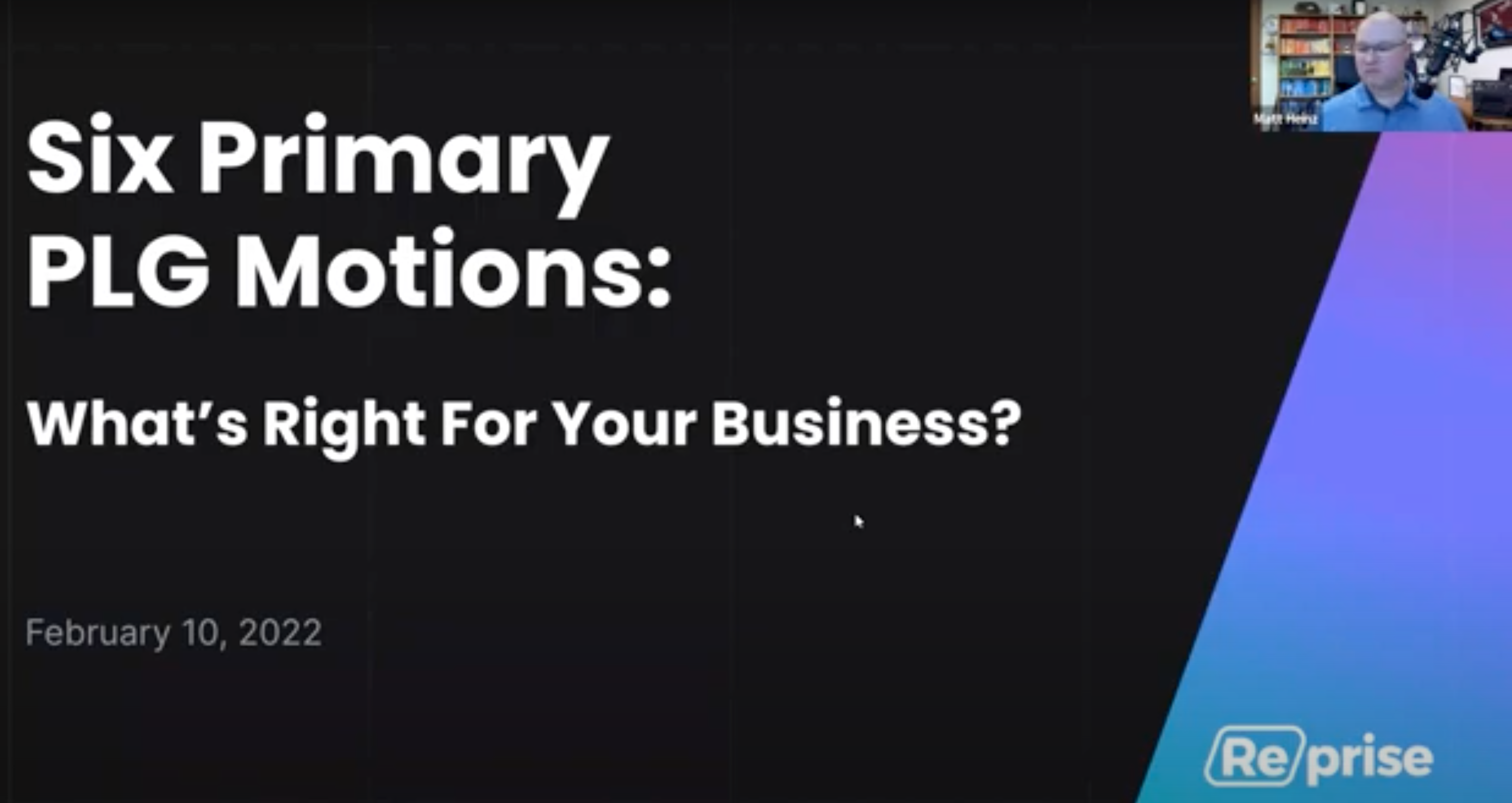Accelerate deals and increase win rates with the leading enterprise AI demo platform.
Six Primary PLG Motions: What’s Right For Your Business?

April 22, 2025
Table of Contents
Sometimes, discussions of product-led growth can make it seem like one narrow motion – using your product to sell your product. But really, there are many different ways to go about PLG. And choosing the right one, or combination, can make your go-to-market motion more successful.
6 Primary PLG Motions
So let’s dive into the six primary PLG GTM motions, as discussed by Reprise VP of Marketing Jenn Steele and Matt Heinz, President of Heinz Marketing Inc, in a recent webinar hosted by our partner Pavilion.
1. Freemium
With a freemium model, you have a lightweight version of your product that is free forever. Freemium reduces your barrier to entry to just signing up and downloading your product, and allows users to get a sense for how your product works. Plus, you’re building interest in the non-limited paid model of your product if you’re introducing the right scarcity barriers as well.
To do freemium successfully, you need to know your audience really well and what’s valuable to them to make this work – meaning tipping them from free to paid at some point. It can be hard to find that balance of free and paid features, but customer success probably has lots of data and insights on this and can help prioritize features that work.
Slack is an example of a company that does a really good job at the freemium model. They’re great at selecting features that are limits (like the Archive feature is great in the Pro version), and that encourage that transition to paid without pushing too hard.
You also need to consider, who are you letting have that free version? Are you naturally compelling them to use the paid version? Sometimes freemium models don’t even ask you to pay, even if you would – and that’s money left on the table. It also tends to bring in down-market like startups (it’s often a hurdle for enterprises to install), so keep that in mind.
2. Free Trial
In a free trial, prospects are getting most if not all of the product (unlike freemium which is a lightweight version). They can immerse themselves in everything, and nothing is hidden here. For some services this works better than others – like if it’s really complex and you need training to make it work, a free trial isn’t usually a good solution.
Sometimes taste tests just aren’t enough, because the user can’t grasp the product that fast or the free trial period isn’t enough time to see the benefits. And of course, you still need to provide a good customer experience to all those prospects as well as your paying customers. Free trials are sometimes better with an SE to come alongside the user as a kind of guide, so that’s something to keep in mind here.
If lots of prospects are signing up for your trial but aren’t converting at the end of it, you need to rethink your strategy here. Security companies have a tough time using free trials, for example, because they can’t integrate with sensitive systems for just a short time.
3. Deep Fakes
Jenn notes that companies hate this term, but basically deep fakes are lightweight product tours. They’re clickable, usually guided, and users can touch and see things in a way that’s not a video. They get a lot more comfort with what’s behind the curtain.
Pendo.io does this really well – they let you see two of these tours before they gate them. And they break them down by persona or usage so you can see the features that are most important to you. It’s kind of an evolved version of a free trial, so you can be in it and using it but without the bother of an install and integration.
But these aren’t without effort – to make them work, you still need to know the why, and there needs to be some kind of storytelling behind what it’s achieving and what it is fighting against.
Deep fakes are great because walking through absolutely everything in your product is overwhelming. How can you get to just those aha moments and experiences you can create? Technical customers love to see how things work and click, so deep fakes work well for that audience.
4. Snacks
Snacks are delicious little content snippets of value you can provide to prospects. They could be samples of data, content, guides, tools like HubSpot’s Website Grader, or a “request a strategy call” button on a business website.
Essentially, they allow you to start getting into the work. Jenn was employee 90 at HubSpot in their very early days, and their Website Grader tool was a great lead generator. Anyone who used it, you knew they were worried about how their website was doing on the internet, so it was a great intent signal.
The key to a snack is making it easy to use and share with others. You can combine them with other PLG methods too.
5. Usage Based Pricing
It can seem at first glance like usage-based pricing is just a variation of freemium vs. paid, but there’s a key difference here. Going from paid to paid is less activation energy than free to paid. Your users are already seeing enough value to pay, you just want them to pay more the more they use it.
Customer experience here is really important. And many companies don’t do it that well, frankly. Often, to add seats or usage for a team that’s already using and paying, you need to go through a whole procurement process when we just want an “add user” button. It’s fine to do usage-based pricing, but let people give you money easily! Otherwise it can be hard to expand as much as your customers actually want to.
The best way to think about usage-based pricing vs. seat-based pricing is figuring out the clearest way for your customer to understand your pricing. Seats-based pricing can work better to start so your users don’t feel like they’re getting nickeled and dimed, but then usage-based pricing can sometimes work later once expansion happens.
6. Expand / Upsell / Cross-sell
One really important thing to consider when deciding on a “land and expand” or upsell model is that your buying committee might not be the same people as your users. In fact, they probably aren’t.
That means when you think about the customer lifecycle, use cases, needs, and personas, you also need to consider the relationships between buying committees and users, who needs to have a great experience using the product and who needs to be communicated to about the value of buying the product.
Matt notes that as an executive buyer of software, there are several tools he buys that he never uses even in his small organization. But he’s happy to have the conversation, especially if you tell him something like, “here are your team’s results from using the product this much – if you use it 3x more you’ll get these benefits.”
If you can communicate that kind of info inside the product, that works but it also requires a lot of development and engineering. But a CSR sending an email can be effective, whether it’s to the buyer or the user team or both.
Keep in mind however that just a company or person is using the product now, doesn’t mean they’re going to re-buy. Churn happens when sellers get complacent and don’t identify the way forward, or aren’t constantly communicating based on what people care about and what they want and need to hear.
If you ignore this except for right at renewal time, you’re setting yourself up for a lot of churn.
Key PLG GTM Lessons
You can see where these six motions can blend together a bit (or a lot, if that ends up working for you!). People want to touch and see and use your product – that’s what it all comes down to. And your product is awesome, so you should let them. It’s how buyers want to buy now, and it’s not a passing trend.
But it is a change – a potentially large one – so you need to do change management. Be thoughtful about picking and choosing what you want to do, what resources need to be involved, and the need to manage the change. And it’s totally possible to do it full-funnel!
PLG is not a campaign – it’s a culture change. It isn’t always easy to do, but we’re seeing so many companies leaning into it and seeing remarkable differences in their GTM performance. In a category where we’re seeing increasing marketing costs and security scrutiny, this can make a huge difference. PLG is an opportunity to own and manage those relationships with prospects early on, directly within your product.
And then, Jenn says, you can stop complaining about millennial buyers and start selling to them!
Thanks to our partner Pavilion for hosting this event.
Watch the full webinar here:






